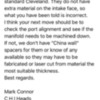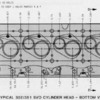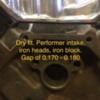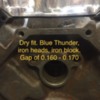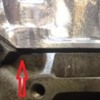All,
I checked on the assembly of my 404 stroker Cleveland last week, and there is an assembly issue that neither me, my builder or others I have spoken with can explain.
The block is an iron four bolt version bored 10-over. The heads are new, out of the box CHI 4V aluminum and the intake is a new, out of the box blue thunder Pantera version.
Both the front and rear China-wall gaps, between the block and the intake, are approximately 1/4 inch wide, perhaps even a little bit more.
All the intake manifold bolts dropped into their respective threaded holes slick as butter.
Assembly of the manifold used the cork gaskets and additional RTV to completely close the gap.
No one seems to have an explanation as to why this gap is so large.
Has anyone ever come across something similar, or have any input that might explain this?
As always, thanks,
Larry
Sent from me using a magic, handheld electronic gizmo.
Original Post


